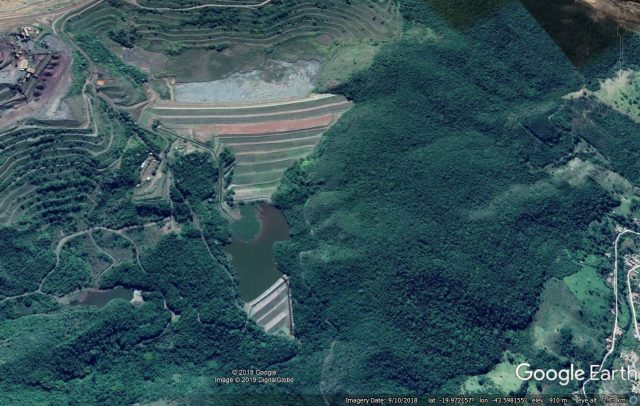25 March 2019
Sul Superior: another Vale tailings dam at risk of imminent collapse in Brazil
Posted by Dave Petley
Sul Superior: another Vale tailings dam at risk of imminent collapse in Brazil
The Brazilian mining company Vale warned over the weekend that its Sul Superior tailings dam, at the Gongo Soco mine near to Barão de Cocais, in the southeastern Brazilian state of Minas Gerais, is at risk of imminent collapse. This dam had been the focus of concern over the last two months, with evacuations from the path of a potential tailings flow starting on 8th February 2019. However, on Friday Vale raised the alert level to 3, the highest classification. The Guardian reports that, according to Brazil’s mining and energy secretary, level three means that “a rupture is imminent or already happening”. It also carries a quote from Lt Col Flavio Godinho, a member of the state civil defence department, that “any activity at the dam could trigger a rupture”.
Back in February, portaldasgerais.com.br posted this image of the Sul Superior dam:-

The Sul Superior dam at the Gongo Seco mine in Brazil. Image via: portaldasgerais.com.br.
.
Indications are that this dam is in the order of 85 metres high, containing a volume of tailings in the range of 3 to 6 million cubic metres. Fortunately, this is somewhat less than was the case at Brumadinho, but is still sufficient to cause enormous environmental damage.
This appears to be the site on Google Earth – the location is -19.972, -43.598:-

Google Earth imagery of the Sul Superior tailings dam in Brazil, which is now considered to be at risk of imminent collapse.
.
There is a very interesting paper available online from the Colombia Water Center (NB PDF), which proposes a hazard assessment methodology for tailings dams, and uses a selection of large facilities in Minas Gerais as an example. Interestingly, the Sul Superior Dam generated a hazard assessment that is 17th out of a list of 28 facilities.It appears that the Brumadinho dam, which is sometimes technically known as Barragem I, ranked 7th on the list.


 Dave Petley is the Vice-Chancellor of the University of Hull in the United Kingdom. His blog provides commentary and analysis of landslide events occurring worldwide, including the landslides themselves, latest research, and conferences and meetings.
Dave Petley is the Vice-Chancellor of the University of Hull in the United Kingdom. His blog provides commentary and analysis of landslide events occurring worldwide, including the landslides themselves, latest research, and conferences and meetings.
The level of expertise required to see this is a construction in distress is low. It is safe to assume that there is no incentive to prevent failing or this would have happened. There appears to be a preponderance of poor practise in the building and maintenance of dams and their regulation.
I suggest that retro fitting repairs is likely to gain little traction as the politics in the areas where this happens is deeply linked to commercial affairs. Both government and business tend to be intractable on these.
What is needed is an organisation that has commercial and scientific representation and backing from governments, investors and customers of the product. To prevent newer constructions that can fail requires something like the International Maritime Organisation which started with small improvements and preventions of future disasters and is now fairly effective
Over time it might try and retro fit solutions but realistically none of these turkeys are going to vote for Christmas as a start.
Sad thing to have to say but fixing the new installations is probably the best that can be hoped for currently, but if there is a better way to stop this happening in the future then it really needs to be promoted. It does mean accepting that installed base may take sometime to get round to making safe, if ever.